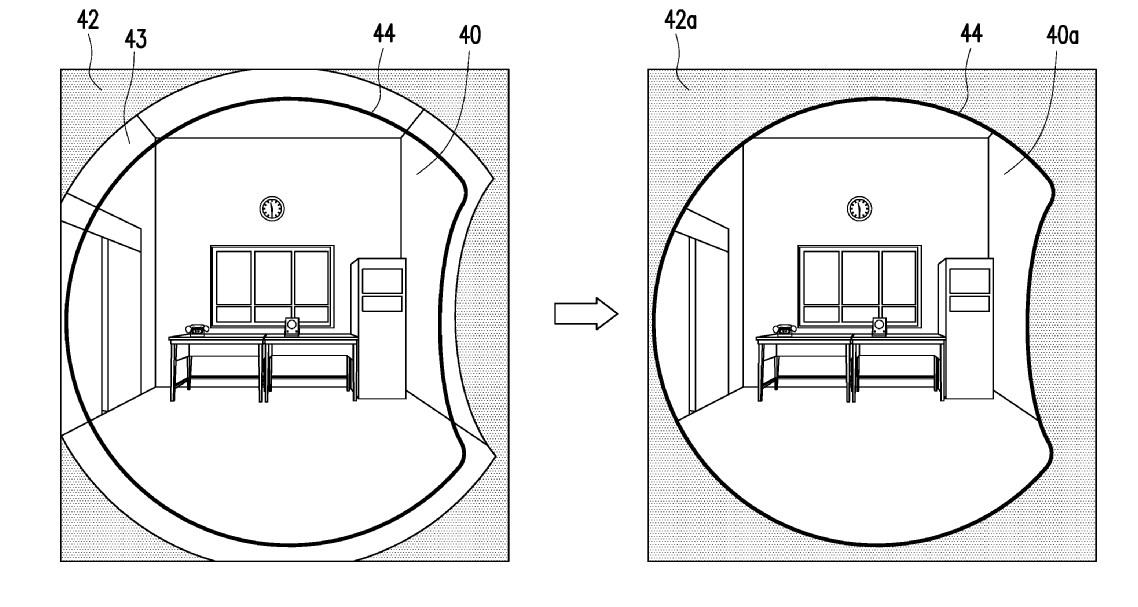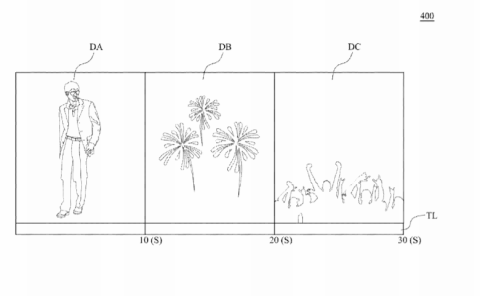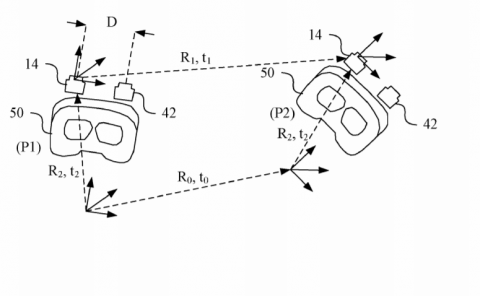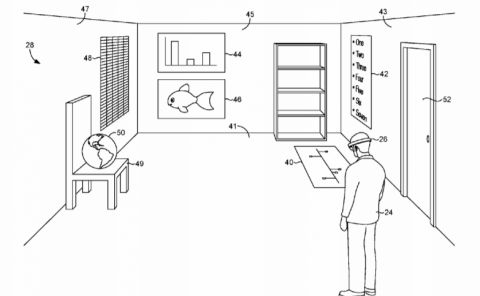HTC | Head-mounted Display System, Method For Adaptively Adjusting Hidden Area Mask, And Computer Program Product
Publication Number: 20180336719
Publication Date: 2018-11-22
Applicants: HTC Corporation

Abstract
The disclosure proposes a head-mounted display system, a method for adaptively adjusting a hidden area mask, and a computer program product. The method includes: displaying a plurality of first content to an eye of a wearer of the head mounted display system, wherein the first content is masked by a first hidden area mask; capturing a plurality of first eye images of the eye and obtaining an eyesight of the eye based on the first eye images; adjusting the first hidden area mask to be a second hidden area mask based on the eyesight of the eye; and displaying a second content to the eye, wherein the second content is masked by the second hidden area mask.
BACKGROUND
1. Field of the Invention
The present invention generally relates to a wearable device and an operating method thereof, in particular, to a head-mounted display system, a method for adaptively adjusting a hidden area mask, and a computer program product.
2. Description of Related Art
Displays with virtual image generation are often used in display devices which are located close to the eyes, so-called near-to-eye displays. Such display devices are known, for example, as head mounted displays (HMD).
An HMD is a display device that a person wears on the head in order to have video information directly displayed in front of the eyes. HMDs are also known as near-to-eye displays. An HMD has either one or two small LCD or OLED displays with magnifying lenses and other optical elements. The displays and optics are typically embedded in a helmet, glasses, or a visor, which a user can wear. Lenses and other optical components are used to give the user the perception that the images are coming from a greater distance, to prevent eyestrain. In HMDs that use a single display, the image is typically projected through optics that split the image into two images, and redirects each image to the respective eye. With two displays, the HMD can show stereoscopic images. The stereoscopic images attempt to create depth in the images by simulating the angular difference between the images viewed by each eye when looking at an object, due to the different positions of the eyes. This angular difference is one of the key parameters the human brain uses in processing images to create depth perception or distance in human vision.
For providing users with great virtual reality (VR) experiences, the HMD are designed to display contents (e.g., images, videos, or scenes) with high resolutions and high framerates. However, these features increase the loading of the graphical processing unit (GPU), which makes the HMD must be disposed with a relatively advanced GPU for maintaining the VR experience to the users. Consequently, the price of the HMD becomes unacceptable to many users.
For lowering the price of the HMD, it is important to design a mechanism for reducing the loading of the GPU while maintaining the VR experiences.
SUMMARY
The disclosure proposes a head-mounted display system including an image capturing device, a display, a non-transitory memory, and a processor. The non-transitory memory stores one or more programs. The processor is coupled to the image capturing device, the display, and the non-transitory memory and executes the one or more programs to: control the display to display a first content to an eye of a wearer of the head mounted display system, wherein the first content is masked by a first hidden area mask; control the image capturing device to capture a plurality of first eye images of the eye and obtain an eyesight of the eye based on the first eye images; adjust the first hidden area mask to be a second hidden area mask based on the eyesight of the eye; and control the display to display a second content to the eye, wherein the second content is masked by the second hidden area mask.
The disclosure proposes a method for adaptively adjusting a hidden area mask, adapted to a head-mounted display system. The method includes: displaying a first content to an eye of a wearer of the head mounted display system, wherein the first content is masked by a first hidden area mask; capturing a plurality of first eye images of the eye and obtaining an eyesight of the eye based on the first eye images; adjusting the first hidden area mask to be a second hidden area mask based on the eyesight of the eye; and displaying a second content to the eye, wherein the second content is masked by the second hidden area mask.
The disclosure proposes a computer program product for use in conjunction with head-mounted display system. The computer program product includes a computer readable storage medium and an executable computer program mechanism embedded therein, the executable computer program mechanism comprising instructions for: displaying a first content to an eye of a wearer of the head mounted display system, wherein the first content is masked by a first hidden area mask; capturing a plurality of first eye images of the eye and obtaining an eyesight of the eye based on the first eye images; adjusting the first hidden area mask to be a second hidden area mask based on the eyesight of the eye; and displaying a second content to the eye, wherein the second content is masked by the second hidden area mask.



